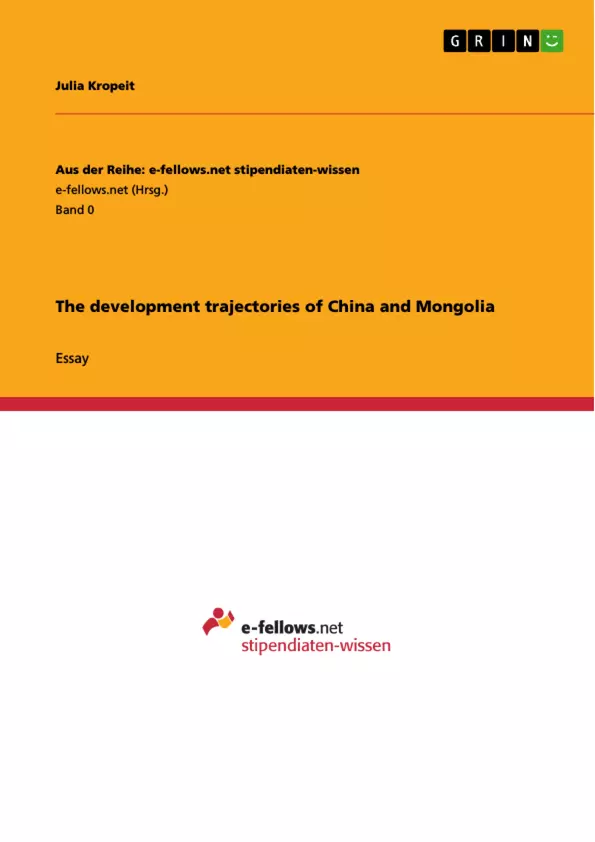China has become a frequently cited exemplary case for the successful economic transitioning from a socialism regime and the enormous act of lifting hundreds of millions of Chine out of poverty over a period of merely three decades. At the same time, Chinas little northern brother, Mongolia, is rarely the focus of comparative development analyses. The least densely populated country in the world has however been on a continuous path of increasing its international economic weight for the past two decades, and with a GDP growth rate of 18% in 2011 belongs to the world’s fastest growing nations.
With the exception of Citibank’s economist Willem Buiter, who grouped Mongolia as one of eleven “G3” countries to become the leading emerging nations of the future, international development studies do not tend to attribute much international significance of the land-locked steppe-country and its 2.8 million inhabitants.
At the same time, however, its Southern neighbor China has been watching closely, keeping an eye out on the enormous amounts of mineral resources which are dozing underneath the ‘world’s bluest skies’. Since Mongolia’s’ strong ties with the Soviet Union broke after a 70-year period of close economic collaboration, the treasures lying underneath the Mongolian steppe have once again come within reach of Chinas resource-hungry industries.
Inhaltsverzeichnis (Table of Contents)
- Introduction: China and Mongolia Today
- Situation before Transition: China
- Situation before Transition: Mongolia
- The State of the Economy after Transition: China
- First stage: 1978-1993
- Second stage: 1994 onwards
- The State of the Economy after Transition: Mongolia
Zielsetzung und Themenschwerpunkte (Objectives and Key Themes)
This essay aims to provide a comparative assessment of the development trajectories of China and Mongolia, two emerging markets that transitioned from socialist planned economies to market-oriented regimes. The essay explores the distinct paths taken by both countries in their transition processes, emphasizing the contrasting approaches to economic reforms, the impact of these reforms on their respective economies, and the resulting socio-economic outcomes.
- Comparative analysis of China and Mongolia's economic transition paths
- The impact of different reform strategies (gradual vs. shock therapy) on economic development
- The role of the state in economic development and resource management
- The socio-economic consequences of economic reforms in both countries
- The influence of international factors on economic development
Zusammenfassung der Kapitel (Chapter Summaries)
- Introduction: China and Mongolia Today: This chapter introduces the essay's main focus, providing a brief overview of the economic situations of China and Mongolia and highlighting the contrasting development trajectories of these two neighboring countries. It emphasizes the significance of the Oyu Tolgoi mining project in Mongolia's economic development and the growing concerns regarding foreign investment in the country's natural resources.
- Situation before Transition: China: This chapter delves into the economic situation of China before its transition to a market economy. It outlines the centrally planned economic model adopted by China, the challenges encountered during the Great Leap Forward, and the economic conditions prevailing after the Cultural Revolution. It highlights the transition towards a more market-oriented approach, emphasizing the importance of the 1970s as the starting point of China's incremental transformation.
- Situation before Transition: Mongolia: This chapter provides a historical overview of Mongolia's economic situation before its transition, emphasizing its nomadic origins and the socialist developments that facilitated the growth of an agricultural-industrial economy. It explores the role of the Soviet Union in Mongolia's economic activities and its impact on the country's industrial production and resource extraction. It also highlights the social advancements achieved during the socialist period and the initial steps towards economic reforms undertaken before the official transition.
- The State of the Economy after Transition: China: This chapter focuses on China's successful transition from a socialist to a market economy, highlighting its unique strategy of gradual reforms. It examines the impressive economic growth, poverty reduction, and improvements in life expectancy achieved during this period, contrasting China's success with the experiences of other transitioning countries that adopted neo-liberal shock therapy. The chapter analyzes the two distinct stages of China's market reforms and the key reform strategies implemented, including the two-sector approach and the dual-track approach to price liberalization.
Schlüsselwörter (Keywords)
This essay examines the comparative political economy of emerging markets, focusing on the transition experiences of China and Mongolia. Key topics include economic reforms, market liberalization, state intervention, resource management, economic growth, poverty reduction, social development, and the impact of international relations and foreign investment.
- Arbeit zitieren
- Julia Kropeit (Autor:in), 2013, The development trajectories of China and Mongolia, München, GRIN Verlag, https://www.hausarbeiten.de/document/1275908


